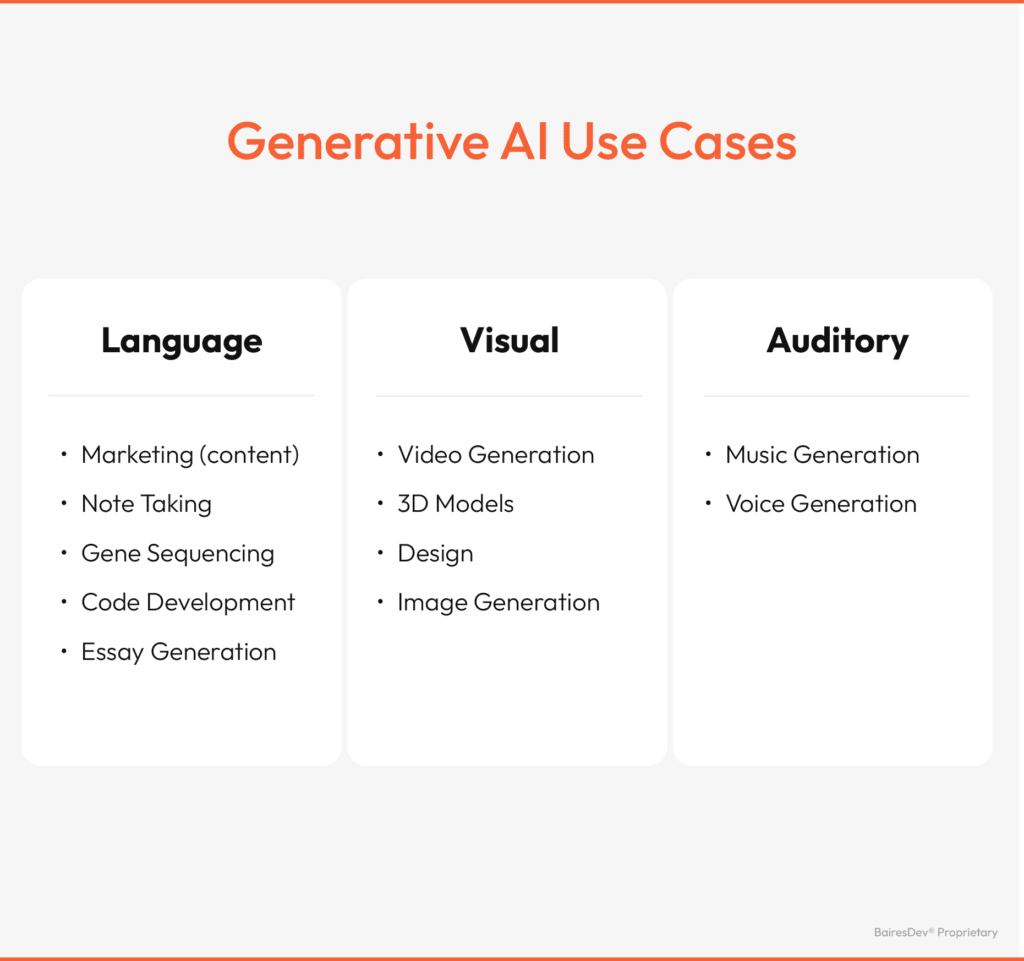You might think AI is a new thing, but it’s actually been making waves since the 1950s. Back then, Alan Turing wrote a groundbreaking paper that got people thinking about whether machines could actually “think.” Fast forward to today, we have a plethora of advanced tools and systems—but with so many choices, how do you decide which one works for your needs?
AI isn’t a one-size-fits-all solution. Its key subsets—generative AI, deep learning, natural language processing, and machine learning—offer unique strengths. Understanding these differences can help you tackle your company’s challenges, optimize your budget, and seamlessly integrate AI into your systems. This guide will help you pinpoint the model that aligns best with your AI strategy.
Exploring AI Subsets: How AI Can Support Your Business Goals
When implementing AI, the best first step is partnering with experts who can help you navigate the complexity of the ecosystem. For now, let’s chat about AI subsets and how they can fit your business objectives.
Generative AI
Generative AI enables machines to create content that mirrors human creativity. Whether it’s generating text, images, or even business plans, this subset shines in automating content creation. Tools like ChatGPT can brainstorm marketing ideas, draft ad copy, or produce visuals, saving time and boosting productivity. For example, you could request an Instagram caption emphasizing your product’s eco-friendly or budget-friendly appeal, freeing up creative resources.

It’s no surprise businesses are quickly adopting generative AI. A Deloitte survey found that 42% of people value it for increasing productivity, simplifying workflows, and saving money. And companies across industries are scaling it up—21% in IT, 14% in marketing, and 11% in product development. A great example of generative AI implementation is Thomson Reuters’ CoCounsel 2.0. This model is a legal AI tool that drafts documents, reviews massive data sets, and finds legal claims faster and more accurately. It helps legal professionals save time and money by automating tedious tasks and allowing professionals to focus on high-priority tasks.
However, generative AI isn’t flawless. One major challenge is “hallucinations,” where the AI confidently outputs incorrect or fabricated information. High-quality training data and human oversight are essential to mitigate these risks.
Ethical concerns also loom large, particularly around misuse like deepfakes—realistic fake videos or audio clips that can mislead or harm reputations. To address this, businesses should establish clear usage guidelines, train teams on ethical AI practices, and invest in tools to detect and prevent misuse.
Natural Language Processing (NLP) Models
Natural Language Processing (NLP) enables AI to interpret and interact with human language, whether typed or spoken. It powers tools like email sorters, which can categorize messages into “client inquiries” or “vendor updates,” and chatbots that handle customer questions or order tracking with conversational ease. NLP also supports language translation and customer feedback analysis, helping businesses streamline communication and enhance user experiences.
NLPs are becoming a big deal across industries. Media and entertainment lead the way, making up over 21% of the NLP market, while healthcare isn’t far behind at 20%. This growth reflects NLP’s ability to optimize workflows and foster better customer connections.
Here’s a quick breakdown of NLP models:
- N-gram Language Models: These predict the next word in a sequence using probabilities derived from prior data. For instance, when typing “return pol…,” it might suggest “return policy,” streamlining user interactions.
- Neural Network-Based Models: These advanced models detect patterns in text, making them ideal for analyzing customer reviews or social media to gauge sentiment.
- Transformers and Large Language Models (LLMs): Models like GPT or GPT-3 excel at contextual understanding and response generation, useful for crafting marketing content, summarizing reports, or personalizing communications.
But, let’s talk about the challenges.
- Ambiguity in Language: Words like “trunk” can have multiple meanings depending on context. Training models with industry-specific examples helps them interpret nuances accurately.
- Data Quality: Incomplete or biased data leads to flawed outputs. Regularly updating and cleaning datasets ensures relevance and fairness.
Multilingual Barriers: Models often struggle with less common languages. Training with multilingual, culturally aware data or using pre-trained models designed for these languages can make NLP tools more inclusive.
Deep Learning Models
Deep learning mimics the human brain’s ability to recognize patterns and make decisions. Built on interconnected layers of “artificial neurons,” these models excel at handling complex data, such as images, videos, and large datasets. Businesses frequently use deep learning for tasks like fraud detection, where it identifies anomalies in transactions and flags suspicious activity in real-time, enabling swift resolutions.
Let’s take a look at the different types of deep learning models.
- Convolutional Neural Networks (CNNs): Designed for visual data, CNNs are perfect for tasks like defect detection in product images, ensuring quality control before shipment.
- Deep Reinforcement Learning: This model learns through trial and error. For example, it can predict when manufacturing equipment requires maintenance, reducing downtime by up to 50%.
- Recurrent Neural Networks (RNNs): RNNs excel at sequence-based tasks, such as analyzing time-series data. An oil and gas company might use RNNs to evaluate market trends over the past year to refine pricing strategies.
Challenges to Address:
- Data Quality: Poor data leads to poor predictions. For example, a retail model unaware of seasonal trends could mismanage inventory planning. Clean, diverse, and current datasets are non-negotiable.
- Bias: Biased training data can perpetuate unfair outcomes, like a hiring tool favoring certain demographics. Periodic fairness checks and synthetic data supplementation can mitigate bias.
- The Black Box Problem: Deep learning models often lack explainability, which can erode trust. For instance, an automotive model predicting issues without clear reasoning may frustrate engineers. Tools like SHAP (Shapley Additive Explanations) can help by breaking down decisions and building trust with clear explanations.

Machine Learning (ML) Models
Machine learning models enable computers to identify patterns and make decisions based on data. Unlike deep learning, which uses complex neural networks, machine learning relies on algorithms like linear regression and decision trees. Businesses apply these models to streamline operations, reduce costs, and uncover actionable insights.
For instance, a subscription-based fitness app can analyze user activity—such as workout frequency, goal completions, and cancellations—to predict churn. Using this insight, the app can offer personalized plans or incentives to retain users. Similarly, a retail company might leverage machine learning to predict demand and optimize inventory, ensuring popular items are always in stock while reducing overstock costs.
Key Types of Machine Learning Models:
- Supervised Learning: Trains on labeled data, making predictions based on known outcomes. For example, an online clothing retailer could predict seasonal sales by analyzing historical trends, helping them prepare inventory and marketing strategies in advance.
- Unsupervised Learning: Identifies patterns in unlabeled data. A grocery delivery service, for instance, could group customers based on purchasing behavior, tailoring promotions for bulk buyers versus frequent small-order customers.
- Semi-Supervised Learning: Combines labeled and unlabeled data. Healthcare providers could classify medical images for early disease detection, even when only a portion of scans are annotated by experts.
- Reinforcement Learning: Learns through trial and error, optimizing actions over time. A logistics company could use this to train autonomous vehicles, rewarding efficient delivery routes and penalizing delays to maximize efficiency.
And, like the other models, there are a few challenges to watch out for.
- Scaling Up: Monitoring and retraining models becomes increasingly complex as businesses expand. For example, a fraud detection system in a fintech company must continually adapt to evolving tactics. Automated monitoring tools and regular audits help maintain performance.
- Data Quality: Ensuring clean, consistent data is critical as organizations grow. A multi-location retailer consolidating customer data might encounter duplicates or outdated entries, skewing predictions. Implementing robust validation processes prevents such issues.
Ethics vs. ROI: Balancing fairness and profitability is essential. A hiring platform might inadvertently favor certain demographics due to biased training data. Regular fairness audits and transparency tools can address these challenges while building trust.
Data: The Backbone of AI Success
High-quality data is the foundation of any effective AI model. While quantity is important, data must also be accurate, relevant, diverse, and up-to-date to reflect real-world scenarios. For instance, training a weather prediction model with random social media trends would be irrelevant and counterproductive.
Diverse data types (e.g., text, images) are essential for robust performance across use cases, reducing biases and ensuring models generalize well. A common practice is splitting data into training and testing sets, often using an 80/20 rule: 80% of the data trains the model, while the remaining 20% evaluates its accuracy. However, this split may vary depending on the dataset size and specific project requirements. Significant discrepancies during testing indicate the need for refinements, whether through data adjustments or model tuning.
External factors often enhance the effectiveness of internal data. For example, a retail chain predicting sales can gain deeper insights by integrating external variables like economic trends, competitor pricing, or weather conditions. These additional inputs help models make more accurate and actionable predictions, especially in fast-changing environments.
Finding the Right AI Fit
Here’s the takeaway: each AI model brings unique strengths. Generative AI is ideal for creative industries to generate content like writing or images. Natural Language Processing (NLP) excels at understanding and responding to human language, which makes it perfect for chatbots. Deep learning handles more complex challenges, like recognizing patterns in images, making it invaluable for manufacturing. And machine learning is great for tasks like anticipating sales trends or segmenting customers.
The common thread across all these models? High-quality data. Clean, relevant, and diverse data ensures accurate and reliable outcomes. Pair that with a skilled AI development team, and you’ll be able to fully harness AI’s potential for smarter decisions and sustainable growth.







